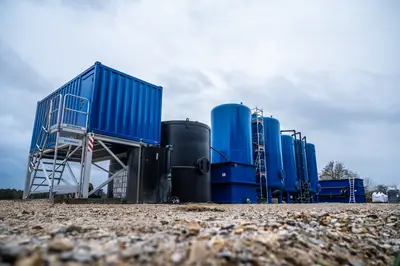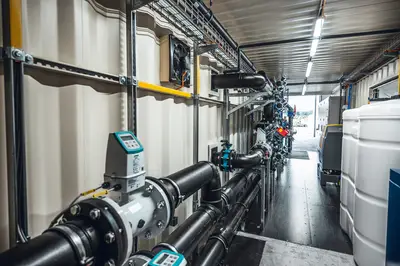So long PFAS: Bauer Resources constructs groundwater treatment plant on Bavarian military site
- Bauer Resources has developed customized groundwater treatment plant to counteract PFAS pollution caused by fire-extinguishing foam
- Strict military safety requirements and unanticipated flooding posed challenges for the site team
- Services include operation, maintenance and repairs
Manching, Germany – A shrill alarm breaks through the silence. In the blink of an eye, the plant fire brigade moves out and not long after, fire-extinguishing foam spreads like a snow-white blanket across the practice grounds. Although this may seem harmless at first glance, it can have serious consequences. This is particularly true if the fire-extinguishing foam contains per- and polyfluorinated alkyl substances (PFAS), a harmful chemical with frequently underestimated risks. On a military site in Manching, Germany, the extent of this risk is clear: The groundwater has been polluted from the use of fire-extinguishing foam for many years. The task for Bauer Resources: construction, operation and maintenance of a tailor-made plant to treat the contaminated groundwater.
Special project, customized plant
The project began in April 2024 – a technically demanding undertaking. This is because the groundwater treatment plant was customized for the client’s requirements down to the smallest detail and fabricated in the Schrobenhausen plant. “Special projects require special solutions,” emphasizes Sales Engineer Sebastian Hohlweg from the Bauer Umwelt Division of BAUER Resources GmbH, then mentions a few figures to explain the dimensions of the plant: “After all, we are talking here about a 40-foot control container, one dosing container, two gravel filters, two liquid phase activated carbon filters, five tanks or vessels and a chamber filter press.” Due to the tight schedule, the plant was completed in just 18 weeks: far from a simple task, as many components such as special pumps and filter tanks had extremely long delivery periods. “For this reason, we divided the components into time-critical and not time-critical parts during the preparatory phase to ensure a smooth working process,” continues Sebastian Hohlweg. This project is unique for the technical specialists: “I can’t remember ever building a plant this big,” proudly remarks Site Manager Harald Huebner from the Bauer Umwelt Division of BAUER Resources GmbH. With an impressive cleaning capacity of 150 m³/h, it is one of the largest plants of its kind in Germany.
“VIP guests” and floods
As with many sites in military areas, the special requirements for project management were challenging here as well. The challenges started right from the moment of accessing the site: “The entire site team had to be registered and reviewed for security on a weekly basis – along with every single piece of equipment, as if they were VIP guests,” explains Site Manager Harald Huebner, adding: “Even the crane for setting up the plant had to be registered several weeks in advance.” In addition, there were strict technical requirements that made careful planning necessary: For example, the structural height of the plant could not exceed 5 m, since the airfield as well as the runway and landing strip are just 20 m away. “Not business as usual, but it was doable,” continues the site manager. Apart from the site-specific challenges, there was also heavy rainfall in the summer. An unexpected flood even led to a site stoppage of around three weeks. “But we don’t surrender so easily,” explains Harald Huebner.
From construction to maintenance
The team led by Site Manager Harald Huebner supervised the project from the start and took care of preparing the construction area on site. After construction of the floor plate, the groundwater treatment plant was brought to the site in more than 15 truckloads. After arriving at their destination, the equipment components were lifted to the defined setup area using a 100-ton crane. Step by step, the various equipment components were then positioned: The filters were filled with gravel and activated carbon, the well pumps were installed, and pipes and wires were laid for the entire plant. In November 2024, it was finally time: The plant began operation. To celebrate this milestone, a press event was also held to inform the public and the media about the project.
And how does the treatment process work in detail? Over a series of wells, the polluted groundwater is extracted and treated in the stationary plant. Then it is reintroduced into the groundwater via an infiltration plant. After a month of trial operation, the regular five-year operation period will begin, including maintenance and repair. All for the sake of the public and the client. After all, the fight against PFAS is a race against the clock.
Press Images



Download
Your Contact
Specialized press Resources, Redevelopment, Environment
